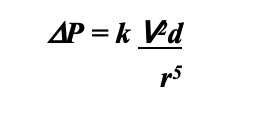F3ix / 18A13: Viscocity Density Gas Flow
18A13: Exam Report
Explain the difference between viscosity and density (10% of marks). Describe the effects of changes in viscosity and density on the flow of gases and liquids (90% of marks).
46% of candidates passed this question.
Whilst most candidates defined density correctly, there was a lot of uncertainty regarding viscosity. Most candidates recognised that flow may be laminar, turbulent or transitional. Most accurately recounted Reynolds number and applied this correctly. Additionally, the Poiseuille equation was correctly stated by most candidates and correctly related to laminar flow. Few candidates recalled the equation describing turbulent flow.
F3ix / 18A13: Explain the difference between viscosity & density (10 marks). Describe the effects of changes in viscosity & density on the flow of gases & liquids (90 marks)
Definitions
- Behaviour of a gas in flow depends on 2 intrinsic properties of the gas
- DENSITY = the ratio of mass to volume
- VISCOSITY = internal property of fluid (gas/liquid) which is a measure of resistance to flow
Flow
- Flow = the volume of fluid (gas/liquid) passing a point in unit time
Turbulent Flow
- Disorganised air flow moving in the same direction
- More likely at high flow rates
- Density dependent ( viscosity independent )
- Described by Fanning Equation
- It is less efficient because ∆P varies directly with V2
- ∴for a given flow, the necessary driving P is greater
- The driving P is proportional to the square root of the flow rate, the density of the gas and inversely proportional 5th power of the tube radius
Transitional Flow
- Flow neither fully turbulent or fully laminar
- There is a gradual transition from laminar → turbulent
Reynold’s Number
- A dimensionless number used to determine if flow is going to be laminar or turbulent
- Low (<2000) = laminar flow because viscous forces predominante
= smooth, consistent fluid motion
- High (>2000) = turbulent flow
= random eddies, vortices, flow fluctuations
= dominated by inertial forces
Helium
- He is a colourless, odourless, non-toxic element
- 2nd most abundant element in the universe, but rare on earth
- Much less dense cf. O2
Gas
Density (g/L)
Viscosity (Poise)
He
0.179
201.8
O2
1.429
211.4
- ∴↓resistance to air flow
- Because will give you lower Re & more likely to give laminar air flow
- ∴Helium can be used in diseases of ↑airway R e. asthma, infant airway obstruction
- Author: Krisoula Zahariou

